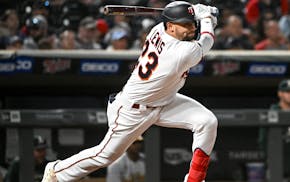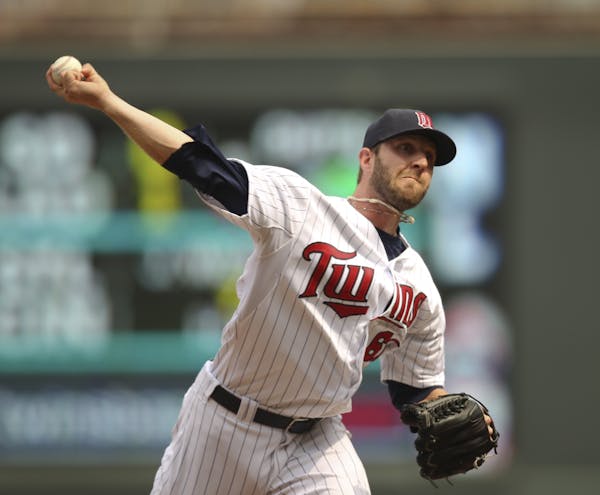Terry Ryan keeps emphasizing the need to find the right manager for the 2015 Twins, and for good reason. It's entirely possible that the new boss in the dugout will turn out to be the most noteworthy, perhaps even the most expensive, free-agent acquisition of the offseason.
That's because much of the Twins' payroll flexibility might have dried up after the spending spree of a year ago, especially amid steadily declining attendance at Target Field. The good news: With the surge of young, inexpensive talent headed to the majors in the next year or two, substantial improvement on the field might not require a substantially greater investment in the payroll.
That's the general manager's opinion, certainly. "Payroll will not be an issue. Our payroll is sufficient to [field] a winning team," Ryan said last week. "There are playoff teams with lower payrolls than ours. … We can't use that as an excuse."
Maybe not, but with a payroll already projected to top $80 million without any additions, Ryan's options appear to be limited when the free-agent market opens next month, at least in part because of the contracts signed a year ago. Team President Dave St. Peter said last week that the Twins will stick to their longtime policy of devoting roughly half of the team's gross revenues to player payroll — and notice how he framed the team's projection for next year:
"We haven't finalized a 2015 budget," St. Peter said, "[but] I can assure you, we don't see it going down significantly."
It's likely that the team's income has, however, given that Target Field attendance has fallen by at least 9.2 percent in each of the past three seasons. It has plummeted by 30.2 percent since the park opened in 2010 and figures to keep declining next season. The Twins also haven't raised ticket prices for three years.
"Every budget has a certain level of risk, and we are mindful of that as we determine our payroll going forward. But we don't expect our revenues to fall off dramatically in 2015," St. Peter said. "It's more than tickets — there are a lot of different pieces to that revenue pie, and we are exploring areas where we might push our revenues. I don't think payroll faces any significant decline."
Still, that means the 2015 payroll is likely to be much closer to the $86 million the Twins ultimately spent in 2014 than the franchise-record $113 million they paid out in 2011. The team won't say how much freedom Ryan has to exceed the budget in the event the team contends for the postseason, but Ryan noted that the Twins' projected payroll temporarily reached almost $95 million this year when he signed Kendrys Morales in early June.
"I spent plenty," Ryan said. "Our payroll was pretty stiff [in July], very respectable. It wasn't the highest, but it shouldn't be the highest."
In fact, it was sixth lowest out of 30 big-league teams, though keeping Morales would have propelled the Twins into the top 20 payrolls if they hadn't traded him. Expect Ryan to have that freedom again next summer, St. Peter said, if the Twins are in contention.
"We would have been happy to see it come in at 95 [million], because it would have meant we were in the pennant race," St. Peter said. Owner Jim Pohlad and his family "didn't blink at all" when the opportunity came up, he said.
The winter marketplace
But what about this winter? Will the Twins be serious bidders on the free-agent market? With their current contracts, don't count on the Twins spending much time talking to the big three free-agent pitchers: James Shields, Jon Lester and Max Scherzer, each of whom reportedly will seek contracts of six years and at least $120 million — and probably much more.
"It isn't just the annual value, it's the number of years that we have to consider," St. Peter said. "We're going to explore all avenues to improvement, but you walk a fine line in free agency between value and risk."
Beyond those pitchers, this is considered a middling class of free agents, and below average for offensive players. Starting pitchers such as Justin Masterson, Jason Hammel and Ervin Santana are all expected to be available. Hitters such as Adam LaRoche, Pablo Sandoval, Melky Cabrera and perhaps Nelson Cruz are expected on the market as well.
"Everyone will be chasing the best ones," Ryan said. "We'll see who has an interest in coming here."
He found a few last year. That's when the Twins splurged, by their standards, in the free-agent market, ringing up $84 million worth of contracts to free-agent pitchers. Of that, $49 million of it went to Ricky Nolasco, who was one of the worst starters in the league in 2014; another $24 million went to Phil Hughes, who was one of the best.
Over the past seven months they spent another $34 million to keep their two 2014 All-Stars, Glen Perkins and Kurt Suzuki, around. They even committed $7.4 million at midseason on an uncharacteristic why-not-us gamble on Morales. That gamble ended up not being nearly so costly; Morales was traded to Seattle before he had been paid even half his salary, and the money spent was made up by the savings the team banked when they traded away Josh Willingham and Kevin Correia.
Willingham and Correia, who had been the Twins' only pending free agents this year, made a combined $12.5 million in 2014. But raises for the current roster will eat up nearly all of the savings from the duo's absence from the payroll.
Tough decisions
In 2015, the Twins have $59.15 million committed to six players, including more than a quarter of the projected payroll, $23 million, due to Joe Mauer in the fifth season of his eight-year contract. If they choose to exercise their option to bring back righthanded reliever Jared Burton, that total increases by $3.6 million; considering Burton's age (33) and the cheaper bullpen options available, the Twins likely will buy him out and make him a free agent for $200,000.
Another seven players (or perhaps eight) are eligible for arbitration, led by third baseman Trevor Plouffe, who could more than double his 2014 salary of $2.35 million. If the Twins decide to keep all of them, expect those salaries to total between $13 million and $17 million. Another dozen minimum-salary players to fill out the roster — including crucial components such as Brian Dozier, Kyle Gibson, Oswaldo Arcia and Danny Santana — will cost roughly $7 million or more.
That brings the current payroll to at least $81 million. Assuming a payroll of around $86 million in 2015, it leaves little space for signing free agents, particularly impact players.
Ryan can free up money by buying out Burton or not offering a contract to arbitration-eligible players such as Brian Duensing, Tommy Milone or Anthony Swarzak. Those will be difficult decisions.
Then again, they all are.
"No one said this is going to be easy. It's going to take a lot of work and a little time," Ryan said. "But the worst thing that could happen is, yeah, we've had four bad years. I don't want it to turn into 14 bad years. Sometimes you make decisions that ultimately are going to benefit you down the line that don't look exactly like what you want right now."
McCutchen leads off with home run for second day in row and Pirates beat Brewers 2-1
Kawhi Leonard is returning to the Clippers' lineup for Game 2 against Luka Doncic and the Mavericks
José Ramírez homers as Guardians continue scorching start with 4-1 win over Red Sox

